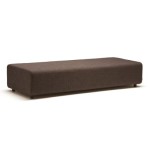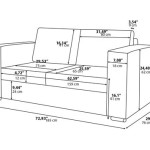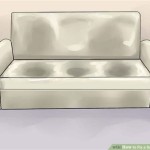Are Sofa Beds Bad For Your Back? A Comprehensive Guide
The question of whether sofa beds are detrimental to back health is a common one, particularly for those contemplating purchasing one or finding themselves using one frequently. Sofa beds offer a versatile solution for accommodating guests or maximizing space in smaller living areas. However, their inherent design, which prioritizes dual functionality, can sometimes compromise the comfort and support crucial for maintaining a healthy spine. Understanding the nuances of sofa bed construction, material quality, and proper usage is essential to evaluating their potential impact on back health.
This article will explore the potential drawbacks of sofa beds, focusing on factors that contribute to back pain and discomfort. It will also delve into steps individuals can take to mitigate these issues and choose sofa beds that are more conducive to spinal health. The information presented aims to provide a balanced perspective, acknowledging both the limitations and potential benefits of sofa beds, ultimately empowering readers to make informed decisions regarding their furniture selection.
The Construction and Mechanics of Sofa Beds
A primary factor influencing the suitability of a sofa bed for back health lies in its construction. Unlike traditional beds, which are designed solely for sleeping, sofa beds must incorporate a folding mechanism. This mechanism often results in a thinner mattress and less uniform support across the sleeping surface. The support system beneath the mattress can also contribute to discomfort. Many sofa beds utilize metal bars or a mesh framework to support the mattress, which may lack adequate cushioning and contouring. Over time, this uneven support can lead to pressure points and spinal misalignment, potentially exacerbating existing back problems or contributing to the development of new ones.
The folding mechanism itself introduces inherent weaknesses. The points where the bed folds are often areas of reduced support, leading to a noticeable dip or sag in the mattress. This uneven surface can force the spine into unnatural positions, increasing the risk of back pain. Furthermore, the overall stability of the frame is crucial. A flimsy or poorly constructed frame can shift and creak during the night, disrupting sleep and further contributing to discomfort. The quality of the hinges and connecting components is also significant. Worn or damaged hinges can cause the bed to become uneven or unstable, negatively affecting spinal alignment.
The gauge of the metal used in the frame is another critical aspect. Thinner metal is more prone to bending and deformation, especially under sustained weight. Over time, this can weaken the frame and compromise its ability to provide adequate support. Similarly, the quality of the upholstery and cushioning materials used in the sofa portion of the bed influences comfort and longevity. Sagging cushions can contribute to poor posture while sitting, which can indirectly affect back health. Regular inspection and maintenance of the frame and mechanism are essential to identify and address potential issues before they escalate into significant problems.
Mattress Quality and Support
The mattress is arguably the most crucial element influencing the comfort and support provided by a sofa bed. Many sofa beds come equipped with thin, low-density foam mattresses that offer minimal support. These mattresses tend to compress quickly, providing little cushioning and failing to adequately distribute weight. As a result, pressure points can develop, particularly around the hips, shoulders, and lower back. This uneven pressure distribution can lead to muscle strain, stiffness, and pain. Furthermore, thin mattresses often fail to isolate motion, meaning that movement by one sleeper can easily disturb the other.
The type of foam used in the mattress also plays a significant role. Traditional polyurethane foam is often less supportive and durable than memory foam or latex. Memory foam conforms to the body's contours, providing customized support and pressure relief. Latex offers a similar level of support but is generally more breathable and resilient. While sofa beds with memory foam or latex mattresses tend to be more expensive, they can significantly improve comfort and reduce the risk of back pain. The density of the foam is another important factor. Higher-density foam is more durable and provides better support over time. Low-density foam, on the other hand, tends to break down quickly, losing its ability to cushion and support the body.
Innerspring mattresses are also available for some sofa beds. However, the quality of innerspring mattresses can vary widely. Mattresses with pocketed coils tend to provide better support and motion isolation than those with interconnected coils. The gauge of the coils is also important, with thicker coils generally providing more support. A mattress topper can be added to a sofa bed mattress to enhance comfort and support. Memory foam or latex toppers can provide an extra layer of cushioning and pressure relief. When choosing a mattress topper, it is important to consider the thickness and density of the material. Thicker, denser toppers tend to offer more support and last longer.
Mitigating the Risks and Choosing a Back-Friendly Sofa Bed
While sofa beds may present certain challenges to back health, there are steps individuals can take to mitigate these risks and choose sofa beds that are more conducive to spinal well-being. Prioritizing mattress quality is paramount. Opting for a sofa bed with a thicker mattress made of high-density memory foam or latex can significantly improve comfort and support. Exploring options for upgrading the existing mattress is a viable strategy if the initial mattress proves inadequate. When feasible, try out the sofa bed before purchasing to assess its comfort and support. Lie on the bed in various positions to identify any pressure points or areas of discomfort.
Considering the frame construction is equally important. Look for sofa beds with sturdy frames made of durable materials, such as solid wood or heavy-gauge metal. Ensure that the folding mechanism is smooth and easy to operate and that the hinges are well-constructed and secure. Avoid sofa beds with flimsy frames or loose hinges. Strengthening the existing support system can enhance comfort. Adding a layer of plywood or a supportive mattress foundation beneath the mattress can provide additional support and prevent sagging. The use of proper bedding can also contribute to improved spinal alignment. Using supportive pillows that maintain the natural curve of the neck can reduce neck and upper back pain. A firm mattress pad can also help to distribute weight more evenly and reduce pressure points.
Adopting good sleeping habits is crucial for minimizing back pain, regardless of the type of bed used. Maintaining a consistent sleep schedule, creating a relaxing bedtime routine, and ensuring a dark, quiet, and cool sleep environment can all contribute to better sleep quality. Practicing proper posture during the day can also help to reduce back pain. Avoiding prolonged sitting, taking frequent breaks to stretch, and maintaining good spinal alignment while sitting and standing can all contribute to a healthier back. Consulting with a healthcare professional is recommended for individuals with chronic back pain. A doctor or physical therapist can provide personalized recommendations for managing back pain and improving spinal health. They can also help to identify any underlying medical conditions that may be contributing to back pain.
Ultimately, the impact of a sofa bed on back health depends on a combination of factors, including the quality of the sofa bed itself, individual sleeping habits, and any pre-existing back conditions. By carefully considering these factors and taking proactive steps to mitigate the risks, individuals can increase their chances of enjoying a comfortable and supportive sleeping experience, even on a sofa bed. Regular exercise and strengthening exercises for the core muscles can also improve support for the back.

Are Sofa Beds Bad For Your Back

Are Sofa Beds Bad For Your Back

Are The Sofa Beds Bad For Your Back Lava Furniture

Are Sofa Beds Bad For Your Back About Bedandbasics Learn More The Company

Are Sofa Beds Bad For Your Back

Are Sofa Beds Bad For Your Back

Is It Okay To Sleep On A Sofa Bed Every Night Pros And Cons

Why Your Sofa Bed Mattress Is Uncomfortable And How To Fix It

How To Sit On A Sofa With Lower Back Pain Adjustamatic Beds

Why Are Sofa Beds So Uncomfortable Blog Raft Furniture London








